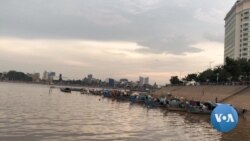Kong Kim, a fisherman in Cambodia's northeast, is worried about the next few years.
"I am concerned that there will be no fish in the future," the 62-year-old told VOA Khmer earlier this week. "Fish are now less and less."
Once he could fish the Mekong River for his family and catch enough to sell as well, he said, but today he hooks just 1 or 2 kilograms of fish where he usually fishes in Cambodia's Kratie province. "In the last two years, fish have declined, and even people who just catch fish near (their) home can't even get one."
"Since there are hydropower dams, the water flow during the dry season has changed," said the father of seven. "Now even during the dry season, there is rising water level."
The Mekong River Commission (MRC) — an intergovernmental body comprising Cambodia, Laos, Thailand and Vietnam — has conducted two new studies that support Kong Kim's observations.
The reports examine the effects of human and environmental incursions in the lower Mekong basin, where Cambodian fisherfolk such as Kong Kim say their catch has declined in recent years.
Environmental groups have long criticized the rapid construction of large hydropower dams along the Mekong River, most recently pointing to the planned 1,460-megawatt Luang Prabang dam in Laos.
The dams, environmentalists say, have disrupted the culture of the communities living along the river, reduced fish populations and, more recently, obstructed the flow of sediment, making the water clear in parts of the Mekong. The seasonal flow of sediment is important to sustaining fertile farmlands near the river.
Overfishing and habitat degradation caused by rapid population growth, infrastructure development and climate change, according to MRC's statement on Tuesday, "are stressing the lower Mekong basin's fisheries while changes in the Basin's aquatic ecosystems are impacting social conditions."
The reports, Status and Trends of Fish Abundance and Diversity in the Lower Mekong Basin during 2007–2018 and Social Impact Monitoring and Vulnerability Assessment 2018, found that households continue to rely on water resources "that are increasingly under pressure."
"These studies further highlight the importance of responsible development, balanced regional and national interest, and stronger regional cooperation in order to safeguard the Mekong River water and related resources," said An Pich Hatda, CEO of the MRC Secretariat.
The commission is urging governments of the four MRC member countries to enforce national fisheries laws and proposes integrating river management plans to address risks from increasing hydropower development.
Seum Noeun, 42, who fishes the Mekong from Koh Dambang village in the Sambo district of Kratie province, said the water level has changed so much it affects fish hatching.
"In the last five years, the number of fish have declined by almost half," said Seum Noeun, who also grows rice and raises chickens and pigs. He now catches only 1 to 3 kilograms a day. Five years ago, he said, he could catch around 6 kilograms of fish a day.
"When the water is high, fish go to hatch, but when it just recedes immediately, the hatchlings will die," he told VOA Khmer earlier this week.
"If there are no fish, I can't support my daughters' study," said the father of three girls, two of whom are in school — grades two and three — and a 3-year-old still at home.
Not too long ago, he could catch enough fish to earn $2.50 to $5 per day. According to the World Bank, the per capita annual income in Cambodia is $1,512.73 as of 2020.
The livelihoods of 60 million people depend directly on the 4,350-kilometer-long Mekong River, according to the New Agriculturist. In 2015, the MRC valued the river's fisheries at $17 billion. As a food source, the river "touches the lives of more than 300 million," according to the World Wildlife Fund. Any regulation of the river's flow, such as dams, has the potential to affect millions of lives.
Om Savath, executive director of Fisheries Action Coalition Team, a nongovernmental organization in Phnom Penh, said the MRC reports reflect his persistent concern about the growing number of dams on the Mekong River.
"In 2019, 2020 and 2021, we have seen the impacts (of dams), especially the water flow from Mekong to Tonle Sap, which has changed a lot, affecting fish both at Mekong and Tonle Sap," he said, adding that the water flows from Mekong to Tonle Sap, the largest freshwater lake in Southeast Asia.
In August last year, authorities reported record low water levels in the Mekong basin for the second straight year.
In Cambodia, the commission said the Tonle Sap Lake, which relies on reverse flows from the Mekong River during the wet season, had recorded its lowest flows since 1997. The lake is a crucial source of fish: It's the source of more than 70% of Cambodia's protein, and it provides livelihoods for millions of Cambodians.
Cambodia has just completed another dam on a Mekong tributary, the Lower Sesan II, and a large mainstream dam on the Mekong River itself, the Sambor, is in the planning stages.
Kol Vathana, the deputy secretary-general of the Cambodia National Mekong Committee, told VOA Khmer that the MRC's reports required a "joint agreement" from the four member countries before release.
He said all MRC members need to coordinate to keep the negative effects of dams to a minimum because no country has the right to prohibit construction of another's dams.
Laos is building two controversial dams, Don Sahong and Xayaburi, while preparing the site for a third, the $2.3 billion Pak Beng project.
China has built eight dams on the river, and more than 20 others are under construction or planned in Yunnan, Tibet and Qinghai, according to International Rivers, an NGO based in Oakland, California.








